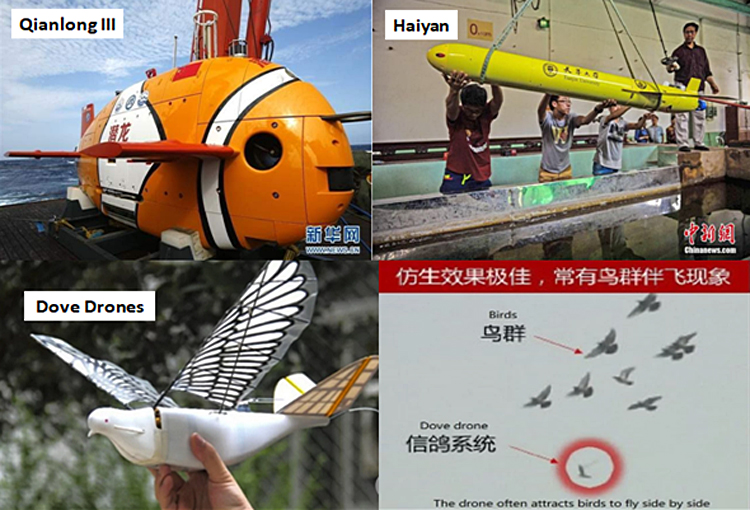INDIAN ARMED FORCES CHIEFS ON
OUR RELENTLESS AND FOCUSED PUBLISHING EFFORTS

SP Guide Publications puts forth a well compiled articulation of issues, pursuits and accomplishments of the Indian Army, over the years

I am confident that SP Guide Publications would continue to inform, inspire and influence.

My compliments to SP Guide Publications for informative and credible reportage on contemporary aerospace issues over the past six decades.
New Chinese drones - formidable challenge
 |
By Lt. General P.C. Katoch (Retd) Former Director General of Information Systems, Indian Army |

China is going full steam in developing drones. Its latest undersea drone 'Qianlong III' is an autonomous underwater vehicle (AUV), which has dived deep into the South China Sea covering a distance of some 160 km in 42 hours. China says it is meant for exploring marine life, seafloor mineral and energy resources upto depths of 1,000 metres but it obviously is dual-use with military applications. Resembling a fish, it has a forward propeller in the eyes, navigation sonar in the mouth, and the vertical tail has a magenometer for detecting metals like manganese nodes or foreign submarines. The Qianlong III can stay underwater for multiple days at depths of 4,500 meters (about 14,800 feet), beating out its Qianlong II predecessor. With a maximum operating depth of around 14,800 feet underwater, this 1.5-ton, 11-foot-long robot submarine is the latest in the inventory of China. Rapid development of underwater drones indicates China's interests in underwater mining, deep-sea energy, and robot ships for civilian freight and military swarms.
China has also developed the 'Haiyan' underwater unmanned vehicle (UUV), which is 1 154 pound drone that can dive some 5000 feet underwater for up to 30 days. These can effectively deployed to hunt enemy submarines and would pose a challenge when used in swarms, depending on how many the submarine under attack can evade, tackle and destroy simultaneously. China had announced its plans for an 'Underwater Great Wall' more than an year back, which would have network of sensors on the seabed, coupled with long endurance UUVs to identify and destroy enemy submarines and mines; underwater drones like the Qianlong III and Haiyan will be essential elements of the Underwater Great Wall. But these can also be used proactively for attacking targets anywhere including in the Indian Ocean, in addition to collecting data about enemy submarine acoustics and oceanographic conditions for improving stealth and anti-stealth measures.
Unknown to many of outside world, China has not only developed and deployed hi-tech 'Dove' drones for surveillance of population but some 30 military and government agencies are regularly using these birdlike drones and related devices in at least five provinces in recent years. Under this new "spy birds" program, code-named "Dove", some 2000 test flights were conducted before deploying the drones in real-life situations. Unlike unmanned aerial vehicles with fixed wings or rotor blades, the Dove drones actually mimic the flapping action of a bird's wings to climb, dive and turn in the air; replicating about 90 per cent movements of real doves, also producing very little noise, making them hard to detect especially since they attract actual birds to fly alongside them. The Dove drone weigh 200 grams, have a wingspan of about 50cms and can fly at speeds of up to 40km/h for a maximum of 30 minutes. Each machine is fitted with a high-definition camera, GPS antenna, flight control system and data link with satellite communication capability. The flapping mechanism comprises a pair of crank-rockers driven by an electric motor, while the wings themselves can deform slightly when moving up and down, which generates lift and thrust to drive the drone forward. Special software helps counter jerky movements to ensure filming of pictures and video by on-board camera remains unaffected. Significantly, even a holographic radar new technologies under development may not be able to detect the Dove drone with wing-flapping pattern almost identical real doves. Camouflage and / or addition of real feathers could distort radar signature even more, making them serious threat for air defence systems.
China is using the Dove drones for surveillance of the population in its border region including the troubled Xinjiang Province. The next step possibly would be injecting these robots with facial recognition, arming with explosive and longer endurance for targeted killings – as witnessed in futuristic gadgetry on social media and movies. This is now real possibility and gives a whole new angle to terrorism and assassinations, especially if such bird robots are launched in swarms. Naturally, such technology is being progressed in other countries as well. In 2013, US Army had procured more than 30 drones that looked like birds of prey, but their wings did not move. More research on such robots is ongoing. India should take serious note of these Chinese developments. With unsettled borders, the China-Pakistan anti-India nexus, Chinese aggressiveness and its policy of ambiguity and deceit, the danger is clear and present. Not that we lack brains in the country, our problem is how to get going to leapfrog technology, overcome red-tape, and field them at required levels in sufficient numbers to overcome asymmetries. The issue is can government meet the challenge while China plans for swarms on the seas and in the air and, floating nuclear power plants, underwater mining and robot freighters, and the like?





